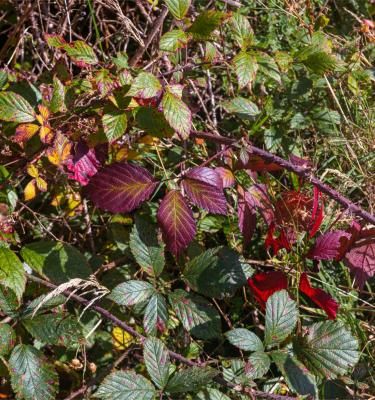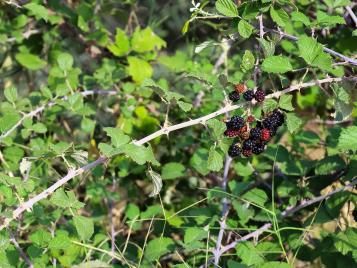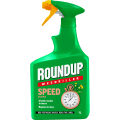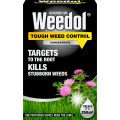

Brambles
What are brambles?
Brambles (Rubus fruticosus), also known as common blackberries, are a familiar sight in hedgerows and woodlands across the UK with their long thorny stems and white flowers in spring, followed by the popular black fruits from summer to autumn.
In gardens, however, they are a vigorous weed, with the canes rooting and spreading wherever they touch the ground. Brambles also spread by underground runners.
Bramble plant identification
Brambles have long, thorny canes that can grow up to two metres or even higher. You can spot bramble leaves by their serrated edges that are dark green on top and pale underneath. They are usually divided into three or five serrated, short-stalked, oval leaflets. The leaf stalks and mid-ribs are also prickly.
Five-petalled white flowers (2-3cm in diameter) appear in spring until late summer (often flowering in June to July), followed by black fruits (blackberries) from July through to autumn. Blackberries are 1-2cm in length. They start life as green, changing to red, followed by deep purple and finally black as they ripen. Blackberries are of course delicious when picked and have long been a cooking staple. Late July to the autumn is blackberry season, and when the picking starts across the country.

Brambles damage
Brambles grow quickly, spreading to form dense thickets of thorny stems that are difficult to penetrate, making them hard to control. They compete with other plants for water and nutrients and can take over neglected areas of a garden.
Their flowers are a good source for bees and other wild animals, whilst their ripe berries attract foxes and badgers, as well as small birds.
Brambles control and treatment
The first approach when getting rid of brambles should be to dig them up by hand. Weedkiller may be necessary to eradicate very established brambles. The best weedkillers for brambles are systemic weedkillers containing glyphosate.
Clearing brambles without chemicals
- Cut back the long stems with secateurs or loppers, using heavy-duty gloves or gauntlets to protect your hands against the thorns. Leave around 30cm (1ft) of the plant above ground to hold on to when pulling it up.
- Shred the stems and use as mulch, or send them to your local council green waste facility. Do not put bramble roots or stems on a home compost heap, as they may root and re-grow.
- Dig the bramble up, removing as much as possible of the roots, as brambles can grow back from roots left in the ground.
How to kill brambles with weedkiller
- Cut back all long stems to around 30cm (1ft) above ground level and dispose of as above.
- Apply a weedkiller suitable for woody weeds, such as Roundup Ultra, following the manufacturer’s instructions.
How to prevent brambles in your garden
So, how do you prevent brambles from growing in your garden? The following garden maintenance is essential.
- Mulch new beds thickly with organic material (e.g. compost) to stop bramble seedlings taking root. The loose texture of the mulch also makes any young weed seedlings easy to pull up.
- Check beds regularly and remove any young bramble seedlings promptly.












